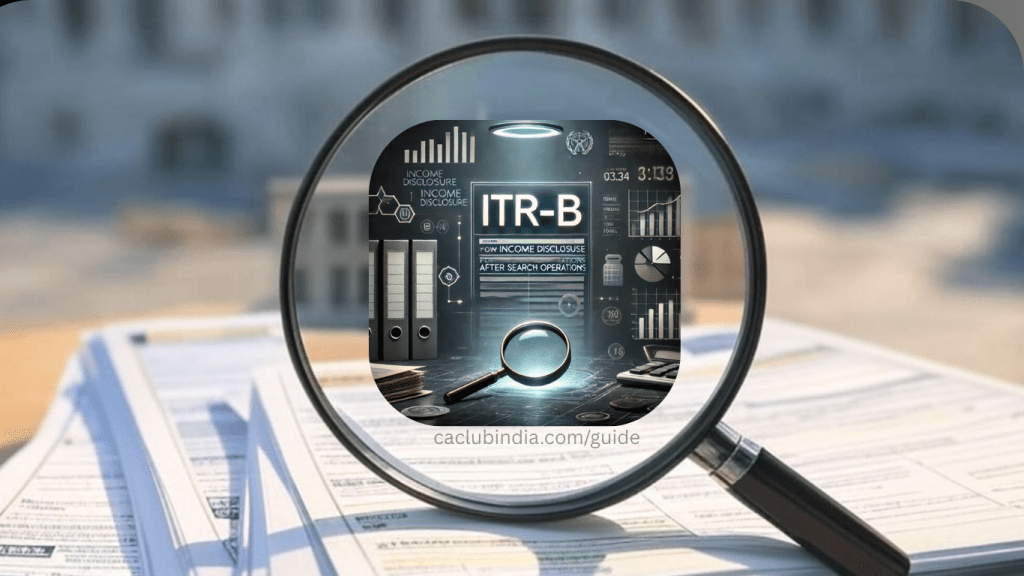Form ITR-B is a new income tax return form which is specifically designed for taxpayers subjected to search or requisition operations, who need to report income that was not disclosed earlier.

Applies To
Taxpayers who have undergone search operations u/ 132 or requisition actions u/s 132A of the Income Tax Act, commencing from 1st September 2024 are required to file Form ITR-B. .
What To Report?
To report any income they have not been declare (such as money from business, property or other sources) earlier, which was found during these operations.
It also includes details of assets like cash, gold, or property that weren’t declared before.
How is ITR-B Different?
This filing pertains to the disclosure of income not previously reported.
Unlike regular ITR forms that cover a single financial year (like ITR-1 or ITR-2), but ITR-B covers multiple assessment years at once.
It is for a “block” of up to 6 previous assessment years before the year of the search, plus the current year up to the search date.
Claiming of Tax Credits
In this Form, you will be able to claim credits for taxes already deducted or collected (such as TDS, TCS) but the tax officer will verify these.
Filing Timeline
Taxpayers are required to submit Form ITR-B within 60 days from the date of receiving a tax notice u/s 158BC following a search or requisition operation.
This timeframe ensures prompt reporting and assessment of the undisclosed income.
Filing Procedure
Return must be filed electronically under digital signature for those – companies, political parties, and persons requiring audit under Section 44AB
For other taxpayers return can be filed either electronically under digital signature or via electronic verification code (EVC).
To know more click here.
Assessment Years Covered
Assessment Year Y6 to Y1
Six assessment years preceding the assessment year relevant to the previous year in which search was initiated undersection 132 or any requisition was made under section 132A.
Assessment Year Y0
- Where search/requisition is concluded in the same year in which it was initiated: Y0 is the period in the assessment year relevant to the previous year which will be from the 1st April of the year in which search/requisition initiated upto the date of execution of the last of the authorisations for search or requisition.
- Where the date of execution of the last of the authorisations for search or requisition falls in a previous year subsequent to the year in which the search or requisition was initiated: Y0 is the complete assessment year relevant to the previous year starting from the 1st April of the year in which search/requisition is initiated and upto 31st March of that year.
Assessment Year Y+1
(To be filled in case the date of execution of the last of the authorisations for search or requisition falls in a previous year subsequent to the year in which the search or requisition was initiated)
Y+1 is the period in the assessment year relevant to the previous year which will be from the 1st April of the year in which last of authorisations of search/requisition was executed and ending with the date of last of authorisations of search/requisition.
| These labels (Y6 to Y1, Y0, Y+1) will help you to figure out which years’ income to report in ITR-B after a search. It ensures all unreported income including past and present is covered, depending on when the search happens and how long it lasts |
Provisions under Section 158BB
Refer section 158BB(1A)(c)(i)
For the purposes for filing details of the assessment year Y1 where the relevant previous year has ended and the due date for furnishing the return under section 139(1) for such year has not expired, where accounts are not audited (if they are required to be audited), provisional figures are required to be furnished based on the books of account maintained in normal course.
This shall not be considered as a return under section 139(1) for the relevant assessment year. Further, this income is required to be included in the return of income furnished under section 139 for the relevant assessment year.
Refer section 158BB(1A)(c)(i)
For the purposes for filing details of the assessment year Y0 (where Y0 is a complete year) where the relevant previous year has ended and the due date for furnishing the return under section 139(1) for such year has not expired, provisional figures are required to be furnished based on the books of account maintained in normal course.
This shall not be considered as a return under section 139(1) for the relevant assessment year. Further, this income is required to be included in the return of income furnished under section 139 for the relevant assessment year.
Refer section 158BB(3)
In terms of the provisions of this section, any undisclosed income in respect of any international transaction or specified domestic transaction pertaining to the part previous year comprising in the block period is required to be assessed under provisions other than the applicable provisions for block assessment. Accordingly, any undisclosed income on this account is not required to be submitted as part of the block return.”.
Conclusion
The new form is a tool to help taxpayers report hidden income after a tax search, making the process more organized and fair.
Taxpayers must accurately report all undisclosed income for the specified block assessment period using Form ITR-B.
By diligently following these guidelines, taxpayers can fulfill their compliance obligations effectively and mitigate any further legal or financial consequences.